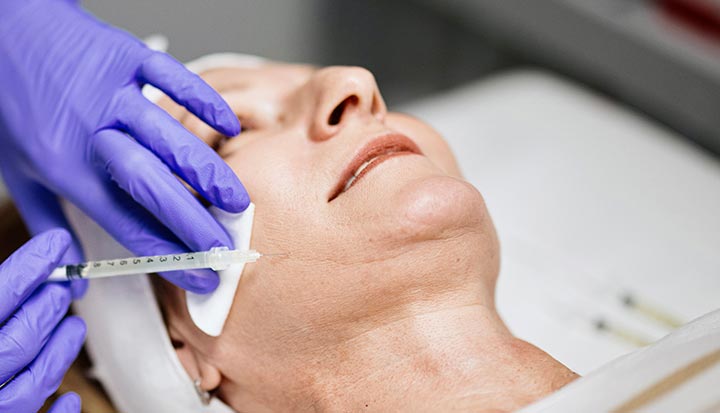Jawline filler injections smooth wrinkles and fine lines, giving your face a more youthful appearance. These dermal fillers add shape, volume and definition to thinning, saggy skin. This nonsurgical cosmetic procedure offers noticeable, immediate results. Jawline filler effects are temporary but can last months or years.
Advertisement
Cleveland Clinic is a non-profit academic medical center. Advertising on our site helps support our mission. We do not endorse non-Cleveland Clinic products or services. Policy

Jawline filler is a nonsurgical cosmetic procedure that gives your jaw area a more defined look. Your healthcare provider injects safe substances called fillers underneath your skin. The filler plumps up your skin. You get smoother-looking skin that looks more youthful.
Advertisement
Cleveland Clinic is a non-profit academic medical center. Advertising on our site helps support our mission. We do not endorse non-Cleveland Clinic products or services. Policy
Jawline fillers are a type of dermal filler. The word “dermal” (dermis) refers to your skin. You may also hear these terms:
You can get dermal filler injections in different parts of your face and body. More than 3 million Americans get some type of dermal filler each year.
You may want a jawline filler to:
There are different dermal fillers that enhance the appearance of the jawline. How jawline fillers work depends on the type:
Advertisement
Over time, your body naturally breaks down and absorbs jawline fillers. How long they work depends on the filler type:
It depends on your aesthetic goals. Your healthcare provider may recommend a jaw implant in addition to (or instead of) jawline fillers. During this cosmetic surgery, a plastic surgeon places a solid silicone implant into your jawline. The implant permanently adds definition and shape to your jawline.
Or your healthcare provider may recommend these nonsurgical cosmetic procedures:
You shouldn’t get dermal fillers if you have:
Different types of healthcare providers can inject jawline fillers. You should look for a licensed provider who has experience with dermal fillers.
Providers who perform jawline filler procedures include:
You can get this quick outpatient procedure at your healthcare provider’s office. You can also get dermal fillers at a medical spa (also called a medspa or medispa). This medical clinic delivers cosmetic procedures in a spa-like environment.
Your healthcare provider will examine your face and discuss your treatment goals. This information helps determine the filler type and amount that’s right for you, as well as the depth and locations of the injections. They may mark your face to show where the injections go. They may also take pictures to show before-and-after results.
Before the procedure, your healthcare provider will review possible side effects. You’ll learn what to expect in terms of results and recovery. Your provider may also recommend other cosmetic procedures or surgeries to help achieve your desired look.
You should tell your healthcare provider about your:
Advertisement
The outpatient procedure takes 10 to 20 minutes. You go home soon after treatment. Your provider will cleanse your skin and apply a topical numbing anesthetic cream. Some fillers also contain a numbing agent to ease discomfort.
Your healthcare provider uses a very thin needle to inject small amounts of filler underneath your skin. You may feel a slight pinch or sting, but the procedure isn’t painful.
Compared to more invasive cosmetic surgeries, jawline fillers offer:
Jawline filler procedures are relatively safe. Any side effects tend to be temporary. They include:
You may have some bruising or swelling after the procedure. These side effects go away in a few days. Still, you should be able to see an immediate and noticeable difference. You can apply cold compresses or ice packs to the treatment area to minimize any discomfort.
Advertisement
Follow your healthcare provider’s recommendations about resuming activities. Depending on the type of work you do, you should be able to return to work after the procedure. Your provider may recommend waiting 24 hours before performing strenuous physical activities.
You should call your healthcare provider if you experience:
A fat transfer (fat grafting) procedure uses fat from your body as the dermal filler. Fat grafting is a more complicated process than a filler injection (although it’s still an outpatient procedure). A plastic surgeon performs this procedure.
Fat transfer requires liposuction, a surgical body contouring procedure. Your surgeon removes fat deposits from one or more areas of your body, like your butt or thighs. After purifying the fat, your surgeon injects it into your jawline.
About half of the injected fat survives, creating permanent lifelong changes. However, you might not get the changes or look that you get with more traditional dermal fillers. The risk of complications is also greater. And recovery after liposuction can take as long as two weeks.
Advertisement
Jawline filler is a fast, noninvasive cosmetic procedure to smooth wrinkles in your jawline. These fillers can enhance your jawline’s appearance and make you look younger. The effects of jawline fillers are temporary. You’ll need repeat injections every six to 18 months. While dermal fillers are relatively safe, skin injections aren’t without risk. It’s important to choose an experienced healthcare provider who can help you get the look you seek.
How you look can affect how you feel. If you’re worried about lines and wrinkles, Cleveland Clinic’s experts can help you navigate the world of cosmetic injectables.

Last reviewed on 06/28/2022.
Learn more about the Health Library and our editorial process.